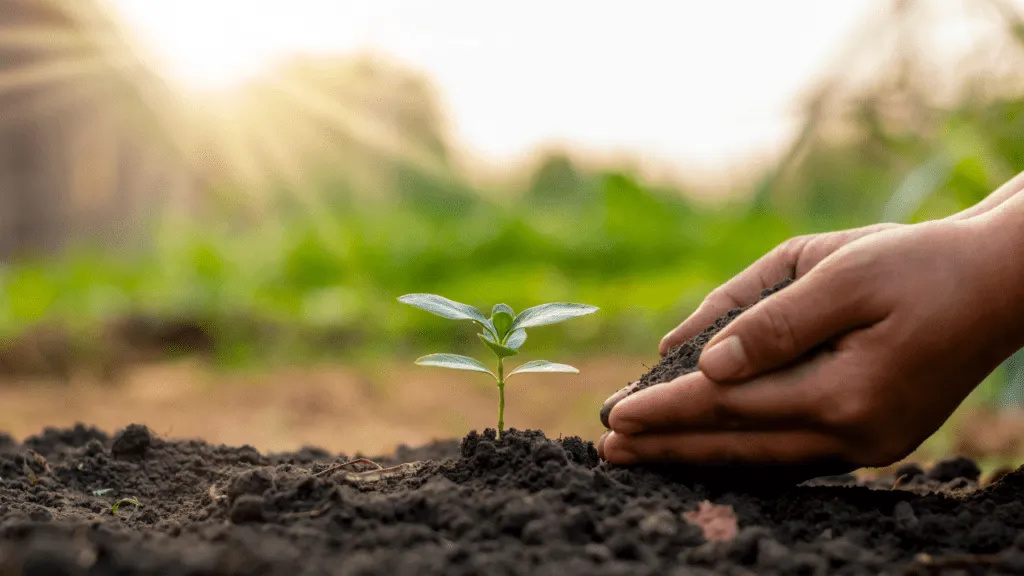Newly planted trees need some extra care and attention. When you provide them with care and attention, they can grow bigger and stronger while greatly contributing to the ecosystem.
Most people struggle to take proper care of plants at the initial stages. Here we will give you 7 tips to care for newly planted trees to help with such struggles.

7 Easy Steps and Tips to Care for Newly Planted Trees
Taking care of trees from the primary stages of a tree’s life cycle determines how well a tree can grow and how long it will thrive in the specific environment. Therefore, one needs to make calculative decisions right at the moment while planting trees.
Here, we will discuss how you can take proper care of a tree from the beginning of a tree’s lifespan.
1. Plant the Right Trees at the Right Places
The first and foremost thing you need to make sure of is that you are planting the right trees in the right spaces. If it is not maintained properly, the tree may not receive enough nutrients or can harm important infrastructure.
So, before planting a tree, select the place carefully. Here are some questions you should answer before selecting the right place for the right tree:
- Will the tree have enough space to grow for its width and height?
- Is there any chance for the tree to damage sidewalks, patios, or a road?
- Will the tree receive enough sunlight to grow?
- Can the tree survive in the local weather conditions?
When these questions are asked and answered, you will be able to find the right tree to plant in accurate space.
Once you have chosen the place and the tree, now you will need to make sure to plant it correctly. The tree flare, where the tree trunk starts to get wider, should always be above the ground. Otherwise, it will face numerous problems while growing.
You can call an arborist if you are struggling with planting your tree. They can even help you select the right space for your tree to plant.
2. Watering the Plants
Once you have planted your trees, you will need to water them on a regular basis. You will need to ensure that the water reaches the tree roots. To achieve this, you will need to slowly water the plants for a longer time.
Sprinkling water may be good for lawns or gardens. However, for trees, it may not help much. Sprinkling water cannot reach the tree roots. Trees need less frequent watering, yet they demand much water at once. Sprinkling water cannot meet this requirement.
A drip irrigation system, a garden hose, a soaker hose, or any system that can deliver water slowly for a long time can be helpful in this manner. However, make sure not to water near the trunk or leaves. Instead, water the root ball and then the area surrounding it. Thus, the root will grow outwards, and the tree will gain strength.
So, how often should you water the plants?
If a tree has a diameter less than 2”, you will need to water it daily for 2 weeks. If the tree diameter is between 2” to 4”, water it daily for a month, and for trees bigger than 4” trunk, watering the tree for 6 weeks is required. After this time, you can water the trees once a week. You will need to continue watering the plants till the tree is well established.
While watering your trees, you should keep the ground around the tree moist, not wet. If the ground is too dry, the plant will not get enough water and die. On the other hand, wet ground can cause tree roots to rot and make the plant die.
Dig up some of the dirt and see the condition to determine how much water you would need. If the ground blows away, the ground is too dry. If you can squeeze out water, it’s too wet.
Depending on tree diameter, you will need to add 10 gallons of water every week for each diameter inch. For example, a tree with a 3” diameter will need 30 gallons of water per week.
During the summer, your trees will need more water. Also, if it rains, make sure the water doesn’t stand in the area. Otherwise, your tree can die.
3. Mulches are Trees’ Best Friend
Mulches are not totally necessary for tree growth. However, they can help trees in multiple ways. Mulch helps trees to retain moisture, control soil temperature, and ward off weeds. Putting down a layer of organic mulch can help tree growth exceptionally.
Here are some organic materials you can use as mulch for trees:
- Leaf mulch
- Wood chips
- Shredded bark
- Pine straw
Also, you should not allow flowers, grass, or other smaller plants to grow near your tree. It will compete for nutrients with the tree and complicate the growth of the tree.
Using a weed warding mulch can help in preventing weed growth around the tree. Thus, the tree can grow properly, and there will be less chance of injuring newly-planted trees while weeding.
You will need to place the mulch 3 – 4 inches away from your tree trunks to gain the benefits. If mulch touches the tree trunk, the tree becomes susceptible to pests and diseases.
Don’t pile up your mulch around the tree trunk. Spread them out on one flat, level surface. Make sure that the root flare is still visible after applying mulch.
Put the mulch 2 -4 inches deep down the ground. Make sure not to pile up the mulch. Also, the further the mulch spreads around from the tree, the better the result you can expect. You should want to spread the mulch as far as the tree canopy extends.
4. Stake Your Trees
Newly planted trees most often don’t need to be staked. However, if it is needed, make sure to remove them after a year or two.
If stakes are left on a tree for too long, it can prevent the tree from establishing a secure root system. Your tree can also struggle to develop a proper form and withstand winds if they are not stacked properly. Eventually, they can kill a tree immaturely in severe cases.
5. Precautions about Fertilizer
It is recommended not to use fertilizers before the tree establishes a secure root system. During the first few years of tree growth, fertilizers don’t help in root growth.
Organic mulch can help trees a lot in this manner. They work as slow-release fertilizers for your precious plants.
You can also add mycorrhizal fungi to the soil while planting trees. However, there are mixed opinions about using these fungi around arborists.
You can ask an arborist to test the soil and determine the best fertilizer for the soil if needed. A professional can help a lot in this manner.
6. Prune the Trees
Let your tree grow for a season before you start pruning your trees for growth and shape. During the early years, your tree will need all the help it can get to produce its food and develop a strong root system.
If any tree branches are damaged while transporting or planting, they should be removed immediately. Otherwise, harmful pests and bacteria can attack the plant.
7. Spend Time with Trees
Keeping an eye on your newly-planted tree can help you exceptionally in taking care of them. Your newly planted tree can be attacked by insects or diseases. Keeping an eye can help you avoid an infestation at the earliest stage.
When a tree is planted, it is more stressed than ever. Therefore, pest infestation and diseases can attack the tree easily. Additionally, you will need to make sure that the soil is not settling or roots are popping out of the soil.
Give your tree to settle down on the planted area for the first few years. It will eventually need less care. However, make sure to check them often. It is very healthy to spend time around trees too.
What to Do for Trees Planted in Hot Climates?
Taking care of your trees is almost the same everywhere. However, if the trees are planted in a hot area, it is better to be more careful.
If the temperature in your area increases more than 90-degree Fahrenheit, you should consider doing the following things during the heat:
Increase Watering
Young trees are vulnerable to extreme temperatures. Therefore, you should increase watering the plants during this time.
If you use 20 gallons of water per week for a particular tree during the general weather, use 40 gallons when extreme temperatures arise.
Schedule Watering Time
It is not utterly necessary to water your plants at the same time every day. However, it can help with consistency and help with a reliable care plan.
It can be very helpful for the plants to get water early in the morning or after sunset. It helps water to stay in the place with minimal evaporation. Thus, your trees can get the optimal amounts of water that they need.
Health Signs to Look for Your Trees
As mentioned earlier, it is crucial to look after your plants even after properly planting. While you are looking after your plants, here are some signs that should be observed with utmost care:
- Leaf Drop: If your plant is shedding leaves other than during the fall, it’s a sign of poor health.
- Leaf Color: Brown or yellow leaves other than during the fall can be a major problem for a tree. Also, check out for black or white spots or coating on the leaves.
- Leaf wilt: If your leaf looks burned, scratched, curled, or sheds too much, it can be caused due to leaf wilt.
- Dieback of branches and twigs: Check out if there are single branches in the tree that are dead or have shredded leaves. Prune it if necessary.
- Bark peeling: Check if tree bark is hanging off the tree that has fallen out completely.
When You Should Call an Arborist
An arborist has an extensive knowledge on trees. They can help you with planting young trees and educate you on how to care for newly planted trees as well. Also, you’re highly recommended to take the assistance of an arborist or a tree service company to help you with that.
Contact Atlas Tree online or call us at (800) 478-7966 to learn more about our tree care and management services. You can consult one of our certified arborists even before planting your trees. We can check out the soil and the area and recommend you choose the correct tree for your property. We can also help you with mulch, fertilizer, and pruning.
If you see any problems regarding your young trees, you should call an arborist as soon as possible. We can help in identifying the tree problems and resolving them. Therefore, you will not have to worry about your trees’ health.
Bottom Line
So, here are our exclusive tips for your younger trees. Following these tips ensures that your tree is planted safely and has a safe environment to grow and thrive.
Don’t hesitate to call an arborist if you need help during any planting process. They are professionals and can help you maintain the optimal tree health condition.
